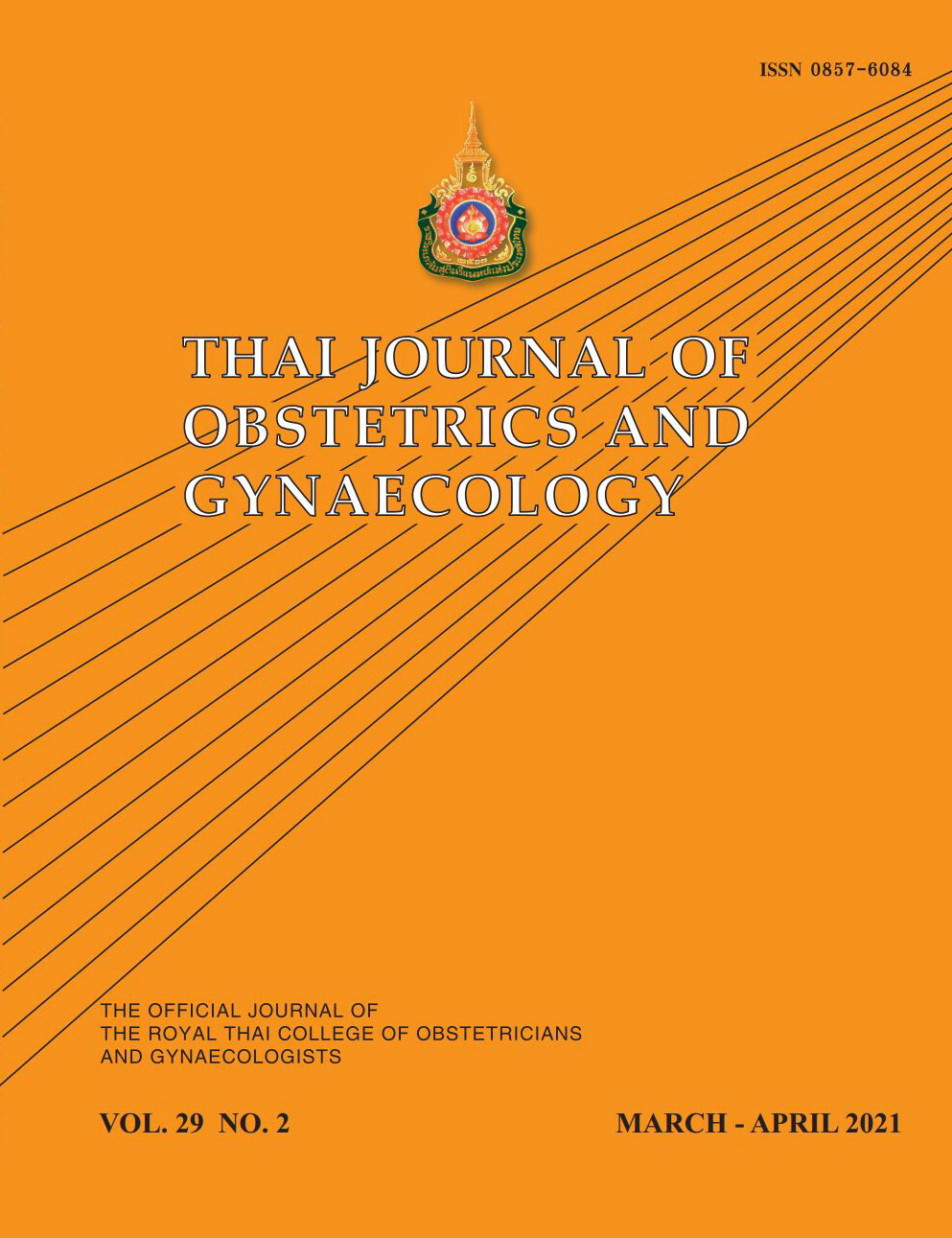Efficacy of Ethyl Chloride Spray versus Subcutaneous 1% Lidocaine Injection for Relieving the Pain of One-rod Contraceptive Implant Removal: A single-blinded randomized controlled trial
Main Article Content
Abstract
Objective: To evaluate the pain scores between using ethyl chloride spray and subcutaneous 1% lidocaine injection for relieving the pain from one-rod contraceptive implant removal.
Materials and Methods: A total of 120 women who intended to remove the one-rod contraceptive implant were randomly assigned to receive ethyl chloride spray or 1% lidocaine injection before the procedure. Clinical characteristics, including depth of implant, were collected. Pain during anesthetic administration, implant removal, and overall pain were evaluated using a visual analog scale (VAS). Participant and procedure assistant satisfaction were assessed. The outcome evaluator was blinded from the anesthetic method.
Results: All patient characteristics were similar between two groups. Pain during anesthetic administration and overall pain in the ethyl chloride spray group was significantly lower than the lidocaine group (median VAS 0 and 3; p < 0.001 and median VAS 1 and 2.9; p < 0.001, respectively). However, pain during the procedure in the ethyl chloride spray group was found to be significantly higher compared to the lidocaine group (median VAS 1 and 0; p = 0.001). Implant removal duration in the ethyl chloride spray group was significantly shorter than the lidocaine group. Participant and procedure assistant satisfaction in the ethyl chloride spray group was significantly higher than the lidocaine group.
Conclusion: Using ethyl chloride spray is effective for relieving the pain during anesthetic administration and overall pain of one-rod contraceptive implant removal, but is associated with higher pain score during the procedure.
Article Details
References
2. Winner B, Peipert JF, Zhao Q, Buckel C, Madden T, Allsworth JE, et al. Effectiveness of long-acting reversible contraception. N Engl J Med 2012;366:1998-2007.
3. Trussell J. Contraceptive efficacy. In: Hatcher RA, Trussell J, Nelson AL, Cates W, Kowal D, editors. Contraceptive Technology: Twentieth Revised Edition. New York: Ardent Media; 2011.
4. Funk S, Miller MM, Mishell DR Jr, Archer DF, Poindexter A, Schmidt J, et al. Safety and efficacy of Implanon, a single-rod implantable contraceptive containing etonogestrel. Contraception 2005;71:319-26.
5. Darney P, Patel A, Rosen K, Shapiro LS, Kaunitz AM. Safety and efficacy of a single-rod etonogestrel implant (Implanon): results from 11 international clinical trials. Fertil Steril 2009;91:1646-53.
6. National Health Security Office N. National Health Security Office (NHSO) [Internet]. Bangkok; 2015 [cited 2019 June 17]. Available from: https://www.nhso.go.th/FrontEnd/NewsInformationDetail.aspx?newsid=MTUxOQ==.
7. Thamkhantho M, Jivasak-Apimas S, Angsuwathana S, Chiravacharadej G, Intawong J. One-year assessment of women receiving sub-dermal contraceptive implant at Siriraj Family Planning Clinic. J Med Assoc Thai 2008;91:775-80.
8. Croxatto HB, Urbancsek J, Massai R, Coelingh Bennink H, van Beek A. A multicentre efficacy and safety study of the single contraceptive implant Implanon. Implanon Study Group. Hum Reprod 1999;14:976-81.
9. Mommers E, Blum GF, Gent TG, Peters KP, Sordal TS, Marintcheva-Petrova M. Nexplanon, a radiopaque etonogestrel implant in combination with a next-generation applicator: 3-year results of a noncomparative multicenter trial. Am J Obstet Gynecol 2012;207:388 e1-6.
10. Voedisch A, Hugin M. Difficult implant removals. Curr Opin Obstet Gynecol 2017;29:449-57.
11. Chevreau J, Krief D, Abou Arab O, Zitoun M, Foulon A, Sergent F, et al. Factors associated with removal difficulties of etonogestrel-containing contraceptive implants (Nexplanon). Eur J Obstet Gynecol Reprod Biol 2018;224:81-4.
12. Golzari SE, Soleimanpour H, Mahmoodpoor A, Safari S, Ala A. Lidocaine and pain management in the emergency department: a review article. Anesth Pain Med 2014;4:e15444.
13. Lehman J, Delateur B. Theraputic Heat and Cold. 4 ed. Baltimore: Williams and Wlkins; 1990.
14. Lawson JI. Ethyl chloride. Br J Anaesth 1965;37:667-70.
15. Polishchuk D, Gehrmann R, Tan V. Skin sterility after application of ethyl chloride spray. J Bone Joint Surg Am 2012;94:118-20.
16. Celik G, Ozbek O, Yilmaz M, Duman I, Ozbek S, Apiliogullari S. Vapocoolant spray vs lidocaine/prilocaine cream for reducing the pain of venipuncture in hemodialysis patients: a randomized, placebo-controlled, crossover study. Int J Med Sci 2011;8:623-7.
17. Moon YE, Kim SH, Choi WH. Comparison of the effects of vapocoolant spray and topical anesthetic cream on pain during needle electromyography in the medial gastrocnemius. Arch Phys Med Rehabil 2013;94:919-24.
18. Hogan ME, Smart S, Shah V, Taddio A. A systematic review of vapocoolants for reducing pain from venipuncture and venous cannulation in children and adults. J Emerg Med 2014;47:736-49.
19. Gupta NK, Upadhyay A, Dwivedi AK, Agarwal A, Jaiswal V, Singh A. Randomized controlled trial of topical EMLA and vapocoolant spray for reducing pain during wDPT vaccination. World J Pediatr 2017;13:236-41.
20. Rusch D, Koch T, Seel F, Eberhart L. Vapocoolant Spray Versus Lidocaine Infiltration for Radial Artery Cannulation: A Prospective, Randomized, Controlled Clinical Trial. J Cardiothor Vasc An 2017;31:77-83.
21. Shefras J, Forsythe A, Nathani F, Hoffman D. An alternative method of anaesthesia for implant insertion: description of a clinical initiative in contraceptive care. J Fam Plann Reprod Health Care 2014;40:226-8.
22. Techasomboon M, Wattanayingcharoenchai R, Bartlett J, Aimjirakul K. Efficacy of Topical Ethyl Chloride Spray versus Subcutaneous 1% Lidocaine Injection in Reducing Pain from One-rod System Implant Insertion. Thai J Obstet Gynaecol 2017;25:266-74.
23. Rekawek P, Stone J, Robles B, Connolly K, Bigelow C, Tudela F el al. Pain perception during transabdominal chorionic villus sampling: a randomized trial comparing topical ethyl chloride anesthetic spray and lidocaine injection. J Matern Fetal Neonatal Med 2019; https://doi.org/10.1080/14767058.2019.1607288.


